
There was plenty of hype going into Saturday’s Biathlon World Team Challenge, a two-person relay event held in the Veltins Arena stadium of the Schalke 04 soccer team in Gelsenkirchen, Germany.
A mostly-annual event since 2002, the races feature many of the World Cup’s top biathletes in competing in relay-style mass starts and pursuits. And for the first time, Martin Fourcade of France, the reigning World Cup Champion, multiple medalist at the Olympics in February, and commonly deemed the best biathlete in the world, was participating.
But biathlon in a soccer arena is not the same as biathlon on real ski trails, and Fourcade didn’t make much of a splash. He and French teammate Anais Chevalier – whom Fourcade had specifically picked for the event – finished eighth in the mass start and fifth in the final pursuit.
Fourcade was still impressed with the whole shebang, though. “What a great experience in @BiathlonWTC!!!” he tweeted after all was said and done.
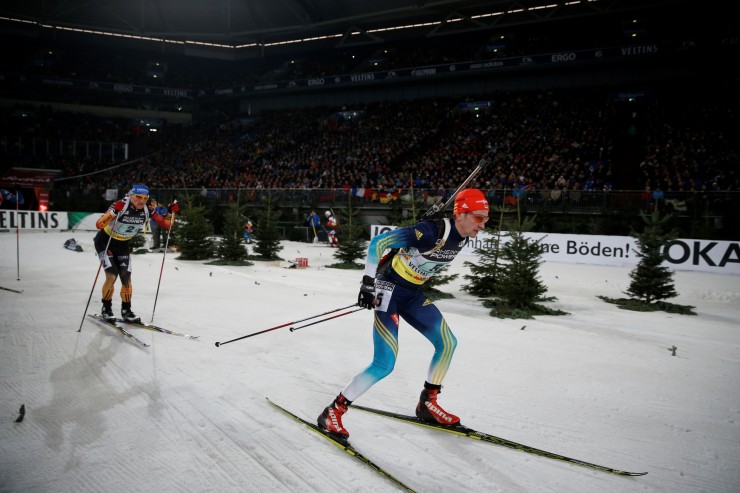
What’s crazier about the event: is it the biathlon, or the race, surroundings, and spectators themselves? We look at each. And if you want a true taste of the event, check out the broadcast by Germany’s ZDF, which has been posted on YouTube.
Ukraine On Top
In each race, the women started by skiing a small loop, which took around three minutes, then shot prone. They skied any penalty loops they might have accrued, then tagged off to the male member of the team, who skied and then shot prone. This continued for eight shooting stages in total: women prone, men prone, women standing, men standing, and then all over again. The men got the honor of racing the final loop to the finish line.
(The format has since been adopted for the World Cup as the “super sprint mixed relay” and will see its debut in Nove Mesto, Czech Republic, this year.)
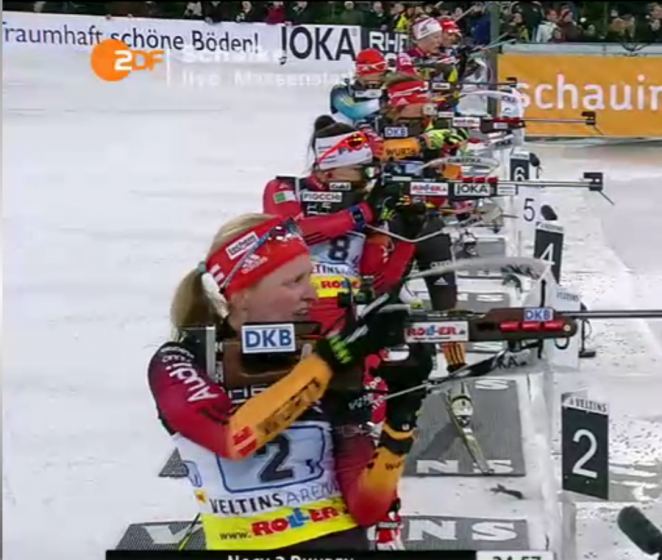
Fourcade and Chevalier were beset by shooting woes, and with such short loops of skiing, Fourcade was unable to make up ground on the trails as he can in World Cup racing. Two other pairs were similarly unlucky: Switzerland’s Elisa Gasparin and Benjamin Weger never figured into either race, and Norway’s Fanny Welle-Strand Horn and Lars Helge Birkeland were never close to the front.
It wasn’t just the short loops that kept strong skiers from strutting their stuff. The entire format is an anomaly for those used to racing difficult World Cup courses with natural terrain. For instance, consider the range approach: the final loop of skiing around the stadium before the ten-lane range (facing a section of the stadium which was blocked off to spectators – no problem, as well over 40,000 people still got to watch live) culmintated in a man-made bridge requiring a few quick and hard V1 strides and then a fast downhill, sharp corner, and the shooting range.
Skiing could still win out over shooting, though. Italy’s Dorothea Wierer and Lukas Hofer won the mass start competition despite having five penalties to the four by runners-up Laura Dahlmeier and Florian Graf of Germany.
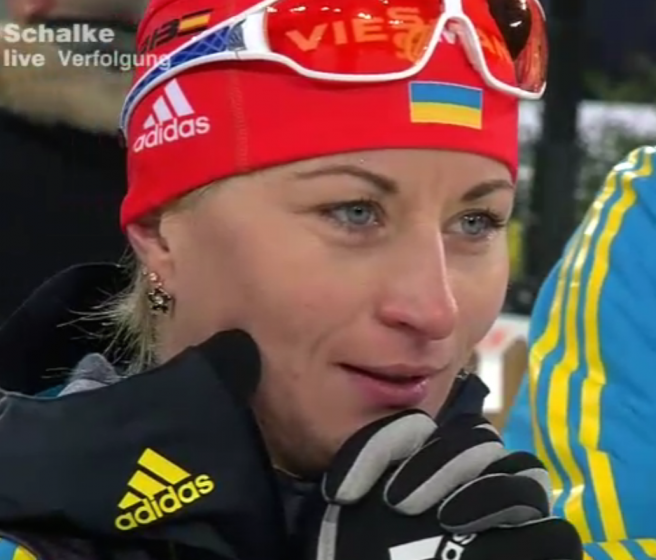
Another German team, Franziska Hildebrand and Erik Lesser, were leading until Lesser – whose shooting speed was unparalleled throughout the day – missed three shots in the final stage and lost the win.
Less than an hour later, the ten teams regrouped and raced again. The format was the same, except it was an interval start based on the finish from the sprint. It would seem that winning the mass start would be a huge advantage – but Wierer and Hofer had a disastrous race, unable to replicate their efforts from earlier in the evening. With nine penalties combined, they finished second to last.
Instead, Valj Semerenko and Serhiy Semenov of Ukraine climbed steadily through the field from their fifth-place starting position to finish on top by seven seconds. They had just four penalties in the second competition.
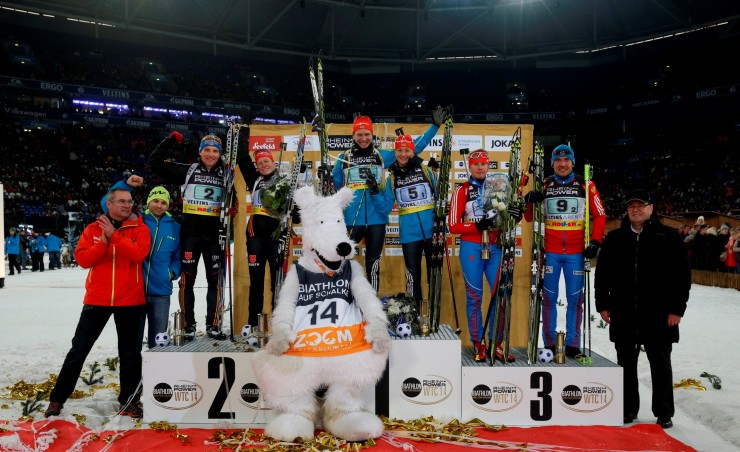
Hildebrand and Lesser matched that tally and finished second, while Russia’s Yana Romanova and Evgeniy Garanichev had the same tally and climbed from seventh into third – not only thanks to the good shooting, but to an aggressive final loop by Garanichev where he not only pulled off a pass of the Czech Republic’s Evgeniy Garanichev, but then put four seconds on him in the final few hundred meters.
The Scenery and Sideshows
Here’s another thing that World Cup racing doesn’t usually feature: institutionalized snowball fights. The event is also the host of the 2014 World Snowball Fight Championships, where teams of three have two three-minute periods to try to annihilate the competition. Helmets and goggles were required.
Also on the docket? A huge display of indoor and outdoor fireworks.
The soccer stadium was filled completely with snow, and trails delineated with large plantings of Christmas trees in the middle to make route easier to follow from the stands. Of course, many a ski race has seen lanes marked with evergreen twigs – but organizers at Schalke take that to a whole new level, creating fake forests of perfectly-spaced trees between the looping ski trails.
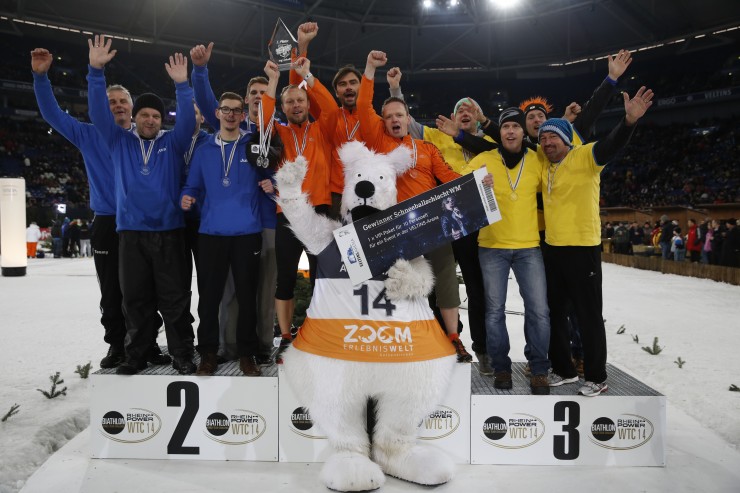
The luckiest spectators were not in the stands but got to watch trailside, on the snow level of the arena. A few of central Europe’s ubiquitous wooden huts were built to serve hot mulled wine.
Between loops, each team’s technicians furiously applied and brushed out layer after layer of fresh fluoros to the skis before athletes grabbed them and ran back to the exchange zone. In the center of the stadium, ski service was as much on display as the skiing.
And finally, a few snafus happened in the race that would rarely be seen on the World Cup: for instance when, at one of the many transitions, Norway’s Fanny Welle-Strand Horn forgot to bring her rifle.
“It was so hectic between stages,” she told Norway’s NRK news broadcaster. “It did not dawn on me until I see Lars Helge come into the exchange. I saw that people were beginning to point towards my back, and suddenly I realized I did not have a gun on my back. Then you get a little panicked.”
Chelsea Little
Chelsea Little is FasterSkier's Editor-At-Large. A former racer at Ford Sayre, Dartmouth College and the Craftsbury Green Racing Project, she is a PhD candidate in aquatic ecology in the @Altermatt_lab at Eawag, the Swiss Federal Institute of Aquatic Science and Technology in Zurich, Switzerland. You can follow her on twitter @ChelskiLittle.




2 comments
highstream
December 28, 2014 at 1:12 pm
Unfortunately, the YouTube video doesn’t carry the snow ball fight.
OEB2ODB
December 30, 2014 at 1:10 pm
I think M. Fourcade skied with Dorin-Habert in the 2012 relay:
https://www.youtube.com/watch?v=xeTo6pexVI4
If this format does catch on, I expect the well-coached teams to quickly rise to the top. The organization and practice required to transition will be interesting to watch. Who is out there practicing 4min intervals, tight turns and tagging?
Thanks Chelsea!